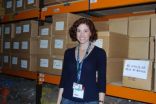(Press-News.org) WEST LAFAYETTE, Ind. — A research team using tunable luminescent nanocrystals as tags to advance medical and security imaging have successfully applied them to high-speed scanning technology and detected multiple viruses within minutes.
The research, led by Macquarie University in Sydney, Australia and Purdue University, builds on the team's earlier success in developing a way to control the length of time light from a luminescent nanocrystal lingers, which introduced the dimension of time in addition to color and brightness in optical detection technology.
Detection based on the lifetime of the light from a nanocrystal as well as its specific color exponentially increases the possible combinations and unique tags that could be created for biomedical screens.
"We now are able to build a huge library of lifetime color-coded microspheres to perform multiple medical tasks or diagnoses at the same time," said Yiqing Lu, a researcher at Macquarie University, who led the research. "The time saved by omitting the need to grow or amplify a culture sample for testing and eliminating the need to run multiple tests will save future patients precious time so treatment can begin, which can be life-saving when managing aggressive diseases."
The technology could enable screens that identify thousands of different target molecules simultaneously, said J. Paul Robinson, the Professor of Cytomics in Purdue's College of Veterinary Medicine and professor in Purdue's Weldon School of Biomedical Engineering, who was involved in the research.
"This is the second part of the puzzle," said Robinson, who led the biological testing of the technology. "Now we've successfully measured the lifetimes of these tags on the fly at thousands of samples per second. The next step is to perform such high-throughput testing within a liquid, like water, blood or urine. That will open the door to widespread biological use and clinical applications, as well as the detection of pathogens in food or water."
Robinson's research focuses on flow cytometry, the analysis of cells that are contained in a liquid flowing past a laser beam. In addition to developing instrumentation to measure the tags, he plans to explore the technology's health care and biodetection applications.
The research team attached unique tags to DNA strands of HIV, Ebola virus, Hepatitis B virus and Human Papillomavirus 16. The tags were accurately read and distinguished at high speeds in suspension arrays. The team's work is detailed in a paper that will be published in the next issue of Nature Communications and is currently available online.
INFORMATION:
Dayong Jin, an Australian Research Council Future Fellow, and a professor of photonics at Macquarie ARC Centre for nanoscale BioPhotonics (CNBP), led the design and manufacture of the nanoparticles, which the researchers named tau-dots.
In addition to Jin, Lu and Robinson, paper co-authors include Jie Lu, Jiangbo Zhao, Ewa M. Goldys, and James A. Piper of Macquarie; Janet Cusido and Francisco M. Raymo of the University of Miami; Jingli Yuan of Dalian University of Technology in Dalian, China; , Sean Yang and Robert C. Leif of Newport Instruments in San Diego; and Yujing Huo of Tsinghua Univesity in Beijing, China.
The Australian Research Council funded this work.
Writer: Elizabeth Gardner, 765-494-2081, ekgardner@purdue.edu
Media contact for Macquarie University: Amy Macintyre, 02-9850-4051, amy.macintyre@mq.edu.au
Sources: J. Paul Robinson, 765-494-0757, wombat@purdue.edu
Dayong Jin, +61 2 98504168, dayong.jin@mq.edu.au
Yiqing Lu, +61 2 98504169, yiqing.lu@mq.edu.au
Related Web sites:
Purdue University Cytometry Laboratories
J. Paul Robinson web page
Related releases:
Timing is everything in new nanotechnology for medicine, security and research
Macquarie University press release
ABSTRACT
On-the-fly Decoding Luminescence Lifetimes in the μs Region for Lanthanide-Encoded Suspension Arrays
Yiqing Lu, Jie Lu, Jiangbo Zhao, Janet Cusido, Francisco M. Raymo, Jingli Yuan, Sean Yang, Robert C. Leif, Yujing Huo, James A. Piper, J. Paul Robinson, Ewa M. Goldys, and Dayong Jin
Significant multiplexing capacity of optical time-domain coding has been recently demonstrated by tuning luminescence lifetimes of the upconversion nanoparticles called "τ-Dots". It provides a large dynamic range of lifetimes from microseconds to milliseconds, which allows creating large libraries of nanotags/microcarriers. However a robust approach is required to rapidly and accurately measure the luminescence lifetimes from the relatively slow-decaying signals. Here, we show a fast algorithm suitable for the μs region with precision closely approaching the theoretical limit and compatible with the rapid scanning cytometry technique. We exploited this approach to further extend optical time-domain multiplexing to the down-conversion luminescence, using luminescence microspheres wherein lifetimes were tuned through Luminescence Resonance Energy Transfer (LRET). We demonstrated real-time discrimination of the LRET microspheres in the rapid scanning cytometry, and applied them to the multiplexed probing of pathogen DNA strands. Our results indicate that tunable luminescence lifetimes have considerable potential in high-throughput analytical sciences.
DOI: 10.1038/ncomms4741
Luminescent nanocrystal tags enable rapid detection of multiple pathogens in a single test
2014-05-08
ELSE PRESS RELEASES FROM THIS DATE:
Cedars-Sinai study: Common drug restores blood flow in deadly form of muscular dystrophy
2014-05-08
LOS ANGELES (May 7, 2014) – Cedars-Sinai Heart Institute researchers have found that a commonly prescribed drug restores blood flow to oxygen-starved muscles of boys with Duchenne muscular dystrophy, a genetic muscle-wasting disease that rarely is seen in girls but affects one in 3,500 male babies, profoundly shortening life expectancy. It is the most common fatal disease that affects children.
Muscle weakness begins in early childhood, often causing deformity of the arms, legs and spine. Heart and respiratory muscles often begin to fail before children reach early teen ...
New study sheds light on survivors of the Black Death
2014-05-08
A new study suggests that people who survived the medieval mass-killing plague known as the Black Death lived significantly longer and were healthier than people who lived before the epidemic struck in 1347.
Caused by the bacteria Yersinia pestis, the Black Death wiped out 30 percent of Europeans and nearly half of Londoners during its initial four-year wave from 1347 – 1351.
Released Wednesday (May 7) in the journal PLOS ONE, the study by University of South Carolina anthropologist Sharon DeWitte provides the first look at how the plague, called bubonic plague today, ...
New care approach eases depression among women
2014-05-08
Women who received collaborative care for depression at an obstetrics and gynecology clinic showed fewer symptoms after treatment than women receiving usual depression care in the same setting, recent University of Washington research found.
The collaborative approach comprises counseling and greater patient engagement than is typical of mental health care at specialty clinics. It involves psychiatrists, clinicians, specialists and depression care managers. The team meets weekly to review patient progress and provide treatment recommendations. The care manager follows ...
First-ever study describes deep-sea animal communities around a sunken shipping container
2014-05-08
MOSS LANDING, CA — Thousands of shipping containers are lost from cargo vessels each year. Many of these containers eventually sink to the deep seafloor. In 2004, scientists at the Monterey Bay Aquarium Research Institute (MBARI) discovered a lost shipping container almost 1,300 meters (4,200 feet) below the surface of the Monterey Bay National Marine Sanctuary. In the first-ever survey of its kind, researchers from MBARI and the sanctuary recently described how deep-sea animal communities on and around the container differed from those in surrounding areas.
In February ...
Mouse study offers new clues to cognitive decline
2014-05-08
New research suggests that certain types of brain cells may be "picky eaters," seeming to prefer one specific energy source over others. The finding has implications for understanding the cognitive decline seen in aging and degenerative diseases such as Alzheimer's and multiple sclerosis.
Studying mice, investigators from Washington University School of Medicine in St. Louis showed that a specific energy source called NAD is important in cells responsible for maintaining the overall structure of the brain and for performing complex cognitive functions. NAD (nicotinamide ...
Improving air quality in NYC would boost children's future earnings
2014-05-08
Reducing air pollution in New York City would result in substantial economic gains for children as a result of increasing their IQs. The study is the first to estimate the costs of IQ loss associated with exposure to air pollution, and is based on prior research on prenatal exposure to air pollutants among low-income children by Frederica Perera, PhD, lead author of the current study, and colleagues at the Columbia Center for Children's Environmental Health at the Mailman School of Public Health.
The researchers made their calculation using a hypothesized modest reduction ...
Listening to bipolar disorder: Smartphone app detects mood swings via voice analysis
2014-05-08
ANN ARBOR, Mich. — A smartphone app that monitors subtle qualities of a person's voice during everyday phone conversations shows promise for detecting early signs of mood changes in people with bipolar disorder, a University of Michigan team reports.
While the app still needs much testing before widespread use, early results from a small group of patients show its potential to monitor moods while protecting privacy.
The researchers hope the app will eventually give people with bipolar disorder and their health care teams an early warning of the changing moods that ...
Why a bacterium got its curve -- and why biologists should know
2014-05-08
Drawing from his engineering background, Princeton University researcher Alexandre Persat had a notion as to why the bacteria Caulobacter crescentus are curved — a hunch that now could lead to a new way of studying the evolution of bacteria, according to research published in the journal Nature Communications.
Commonly used in labs to study cell division, C. crescentus naturally take on a banana-like curve, but they also can undergo a mutation in which they grow to be perfectly straight. The problem was that in a laboratory there was no apparent functional difference ...
Population screening for SCD in young people: Feasible with basic screening program
2014-05-08
Amsterdam, 8 May 2014. Despite fears over cost, the wide-scale screening of young people to detect risk of sudden cardiac death (SCD) is feasible and cost effective, according to a study presented at EuroPRevent 2014.(1) More than 12,000 people aged between 14 and 35 were screened at a cost of £35 (40 euro) each; rates of subsequent referral for further investigation were low and considered of "a relative low additional cost" to health services.
The study was reported at the EuroPRevent congress 2014 in Amsterdam by Dr Rajay Narain, Clinical Research Fellow from the Department ...
Adults with autism virtually learn how to get the job
2014-05-08
CHICAGO --- Adults with an autism spectrum disorder, who may have trouble talking about themselves and interacting socially, don't always make good impressions in job interviews and have low employment rates.
A new human simulation training program -- based on software originally used to train FBI agents -- helps adults with autism improve their job interview skills and confidence, reports a new Northwestern Medicine® study.
The new interactive program was designed specifically for adults with psychiatric disorders and was also evaluated for use by adults with autism ...




